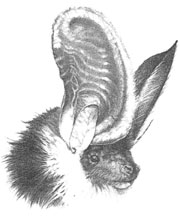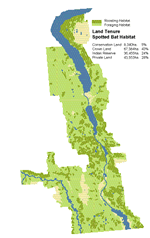|
Habitat Atlas for Wildlife at Risk
Spotted Bat
Euderma maculatum

Spotted
Bat
|

- Length: 12 cm (slightly less than half
is tail); wingspan: 35 cm.
- Enormous ears: approximately 4 cm in length.
- Weight: 18 grams.
- Fur on back is black with three large white spots
located on each shoulder and rump; patch of white
hair at base
of each ear.
Status:
British Columbia Blue List
Canada: Vulnerable
Special Significance
The Canadian population of Spotted Bats appears to
have remained at a relatively constant but low level
for the past five years. The Spotted Bat is considered
to be one of the rarest North American bats. This
extremely shy creature roosts in cliffs, where it
is very sensitive to human disturbance. Recognizing
the rarity and vulnerability of this bat has resulted
in its provincial and national designation as vulnerable.
While Spotted Bats are known to be active in the
Okanagan from late April until October, it is not
known if they overwinter in British Columbia.
Distribution
- In British Columbia, found in the Okanagan, Thompson, Fraser and
Chilcotin valleys to the Williams Lake region; also found in the Similkameen
Valley and Cariboo region but is most common from Osoyoos to Penticton.
Habitat
- Forage in all types of habitats including open and dense coniferous
forests, deciduous habitats, hay fields, marshes,
riparian areas and dry shrub-steppe grasslands.
- Day roosts found in crevices of high steep cliff faces.
- Maternity roosts are in crevices of cliffs or canyon
walls; cliffs are often greater than 100 metres
high.
- Proximity of roosts to suitable feeding areas and a
source of water is important.
- Hibernation sites may be in crevices of cliffs that
are inaccessible to humans or bats may spend winters
outside the province.
- Prefer areas of low human activity.
Reproduction
- Mating is believed to take place in autumn.
- Females are able to reproduce at one year of age; they
produce one offspring a year with young born
in late June or early July.
Food Habits
- Leaves its day roost 30 to 60 minutes after sunset.
- Generally solitary, bats follow a set route to a night-time
feeding area and return to the same roost night
after night.
- Specialized feeder subsisting mainly on moths captured
while flying 5 to 15 metres above the ground; caddis
flies and beetles are also consumed.
- Large ears are held erect during flight and may allow
long-range prey detection.
- Low frequency call may enable bat to avoid detection
by certain species of moths that can "hear" ultrasonic
sonar calls of bats.
Interesting Facts
- Like other British Columbian bats, Spotted Bats emit echolocation
calls to navigate in the dark, locate prey and
possibly to advertise to other bats; however, it is the only bat
in Canada whose echolocation
calls are audible to the human ear.
- Not very social and do not form large hibernating colonies
typical of many other kinds of bats; social interactions
seem to be restricted to mating and mother-infant care.
- In very high temperatures, blood flow to ears and wing
membranes increases to aid body cooling.
- Slow fliers due to rounded wing shape and relatively
heavy body in relation to surface area of wing;
very agile despite slow speed; are able to leap into flight from
ground.
Threats
- Extremely sensitive to human disturbance; likely
to abandon cliff roost sites if disturbed.
- The small population and patchy distribution is
more vulnerable to changing conditions.
- Loss of foraging areas: development of grasslands
and draining and filling of wetlands.
- May be susceptible to residual pesticides in moth
prey.
Management Considerations
- Designate key roost sites in cliffs as protected
areas and restrict disturbance.
- Protect key foraging habitat including low elevation
forests, grasslands and marshes.
- Avoid the use of pesticides, particularly near
wetlands and riparian areas.
- Erect gates at old mine sites to prevent human
access and protect potential roosting sites.
|
References
1. Nagorsen, D.W. and R.M. Brigham. 1993. Bats of British Columbia.
Royal British Columbia Museum Handbook, Victoria, British Columbia.
2. Blood, D.A. 1993. Spotted Bat; Wildlife at Risk
in British Columbia. Brochure. Ministry of Water, Land and Air Protection,
Victoria, British Columbia.
3. Garcia, P.F.J., S.A. Rasheed and S.L. Holroyd. 1995.
Status of the Spotted Bat in British Columbia. Ministry of Water,
Land and Air Protection, Lands and Parks, Victoria, British Columbia
|